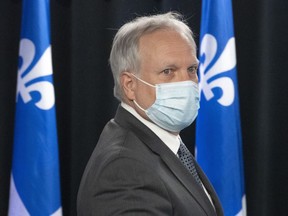Emissions shall not exceed an average of 15 nanograms per cubic meter per year. This is five times the Quebec standard of 3 ng/m3.
Article author:
Stéphane Blais, La Presse Canadienne

Institut national de santé publique du Québec (INSPQ) , suggests that Rouyn-Noranda airborne arsenic emissions should not exceed an average of 15 nanograms per cubic meter per year. This is five times the Quebec standard of 3 ng/m3.
According to Public Health Director Dr. Luc Boileau, who provided an update on the environmental health of Rouyn-Noranda on Wednesday, this threshold will reduce fetal and infant health. It is intended to reduce the risk of developing lung cancer in the general population.
"Achieving 15 ng/m3 is an intermediate step towards reaching the standard," INSPQ's scientific adviser said in a technical briefing for media on Wednesday. It should be achieved as soon as possible," he said. ''
Airborne arsenic emissions from horn foundries have been the subject of much debate in recent weeks. It is allowed to reach ng/m3. This is 33 times the Quebec standard.
Boileau did not comment on a possible timeline for reaching that criterion.
"I don't know," he said, indicating that getting there would require "substantial effort not done in weeks or months." Boileau clarifies that the 15-nanogram threshold "is a formal recommendation to the government," and the government must immediately choose a new emission limit for the horn foundry.
in Quebec At a press conference on
"We don't want to put people's health at risk, so if Public Health is telling us about 15 nanograms, we can't ignore it." I can't, but I can't comment on that right now.Sharet added that he hadn't read the recommendations yet but would "evaluate them in the next few hours." 59} Charette blames the fact that the foundry could emit 33 times more arsenic than the Quebec standard, given that the former Liberal government signed a five-year agreement set to expire. said. in November.
"The foundry is not perfect, but it has used up all the rope the liberals gave it," he said. "But that rope was too long and too big. Yes, it is a good corporate citizen as long as it complies with what the previous government imposed. But that was not enough. Certainly, health That's something that will change with the next certification.''
He added that he will be traveling to Rouyn-Noranda next week.
After the Boileau press conference, Glencore, which owns the Horne foundry, issued a statement, acknowledging the recommendations and saying it was sensitive to "the concerns expressed for the well-being of the community." . has participated in for 95 years.
"We will be working to address the concerns raised thus far, while also contributing to the sustainable development of our community in the coming days. Alexis Segal, Canada.
A few weeks ago, an INSPQ report revealed that over a 70-year period, cancer would develop in disproportionate numbers of Ruin Noranda citizens between the ages of 1 and 14.Glencore does not cause cancerReduces airborne arsenic levels in foundries.
New thresholds proposed Wednesday put the cancer risk at "3 cases per 100,000 inhabitants over 70 years" if compliance with the criteria is respected.INSPQ said: 'Unacceptable risk' corresponds to '10 cases in 100,000 inhabitants'.
Rouyn-Noranda has approximately 40,000 inhabitants, so 3 cases of cancer per 100,000 inhabitants represents 1.2 cases over a 70-year exposure period.
In the report's conclusion, INSPQ found that an average of 15 nanograms per cubic meter per year "contributes to reducing the risk of lung cancer for future generations in the Notre Dame area by about a quarter." is showing. Under current conditions, this is a level considered acceptable in similar North American conditions.
For emergency physician Frederic Bonin, the proposed threshold is "a step in the right direction, but it falls far short."
Those who practice at Rouyn-Noranda Anyone would "hope to see 3 nanograms on their next certificate," he said.
“We have been making bad decisions for the past 40 years. The people of Ruin Noranda have paid the price. should not be paid," he added. , citing data on cancer and other diseases more prevalent in this region than elsewhere in Quebec.
A committee called Arrêt des rejets et émissions toxics-Rouyn-Noranda (ARET) was also disappointed by Wednesday's announcement.
"It is incomprehensible to allow public health to treat a region differently from other regions," said ARET spokesperson Nicole Deganez.
-

Quebec foundry seeks permission to release arsenic 20 times the permissible level
-

Tom Mulcea: A problem with the Horn Smelter has opened a can of Lego worms.

Daily headlines from The Montreal Gazette, a division of Postmedia Network Inc. Sign up to receive news.
Thank you for registering.
Sending welcome email. If you don't see it, please check your spam folder.
The next issue of the Montreal Gazette headline news will arrive in your inbox shortly.


